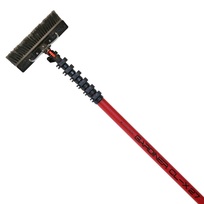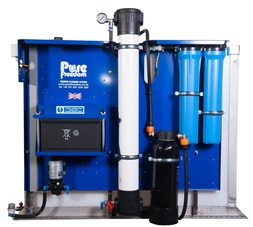Reach and wash - What is it? and how does it work?
The Water fed poleThe Reach & Wash system is a water-fed pole system and the concept is quite simple. Here's how it works...
The extendable pole means that it can be extended to reach windows above ground level. The longer the pole extends, the heavier it becomes, so the maximum height the average window cleaner can clean with a pole is around 65 feet from the ground before it becomes too unwieldy and heavy. New light-weight materials are extending that height limit by a few feet, but it's unlikely to exceed 70 feet by too much for practical reasons. |
Extendable poles of different lengths are available, Soft filament brushes are important because it needs the soft filaments to help remove stubborn stains while ensuring that the glass and frames aren't damaged or scratched. Water is pumped through the middle of the brush to help control where the water flows and to make sure the window gets thoroughly soaked.
Water is delivered through a tube running up the centre of the pole and connected to the brush head. The other end of the tube is connected to a water tank via an electric pump. Water is delivered at high pressures to ensure good flow and the ability to reach the maximum pole heights.
The water we use to clean the windows is purified de-ionised water and has been through a reverse osmosis system.
Water is delivered through a tube running up the centre of the pole and connected to the brush head. The other end of the tube is connected to a water tank via an electric pump. Water is delivered at high pressures to ensure good flow and the ability to reach the maximum pole heights.
The water we use to clean the windows is purified de-ionised water and has been through a reverse osmosis system.
Advantages of reverse osmosis filtering
Reverse osmosis can remove a range of contaminants in water through pores of 0.0005 micron in size.
The 5 Stages of Filtration Are:
1. Micron Sediment Filter Made of 100% Pure Polypropylene Fibres. Removes Dirt, Sand and Rust
2. Granular Activated Carbon Filter Composed of High - Performance Activated Carbon. Removes Chlorine, Odour, Organic Contaminants, Pesticides and Chemicals
3. Carbon Block Filter Composed of High Performance Carbon. Removes Trichloroethane, Pesticides, Volatile Organic Chemicals and 99.95% of Giardia and Cryptosporidium Cysts
4. High Rejection Thin Film Composite Reverse Osmosis Membrane. This Membrane Removes Contaminants Present in your Water Including, up to 99% of Dissolved Salts, Lead, Copper, Barium, Bacterial By-Products, Oestrogen, Silica, chromium, mercury, sodium, cadmium, fluoride, nitrite, nitrate, and selenium.
5. Deionising vessel. It Removes any Residual Impurities and Odours from the Tank and Provides a Finer Conditioning of the Purified Water
Reverse osmosis can remove a range of contaminants in water through pores of 0.0005 micron in size.
The 5 Stages of Filtration Are:
1. Micron Sediment Filter Made of 100% Pure Polypropylene Fibres. Removes Dirt, Sand and Rust
2. Granular Activated Carbon Filter Composed of High - Performance Activated Carbon. Removes Chlorine, Odour, Organic Contaminants, Pesticides and Chemicals
3. Carbon Block Filter Composed of High Performance Carbon. Removes Trichloroethane, Pesticides, Volatile Organic Chemicals and 99.95% of Giardia and Cryptosporidium Cysts
4. High Rejection Thin Film Composite Reverse Osmosis Membrane. This Membrane Removes Contaminants Present in your Water Including, up to 99% of Dissolved Salts, Lead, Copper, Barium, Bacterial By-Products, Oestrogen, Silica, chromium, mercury, sodium, cadmium, fluoride, nitrite, nitrate, and selenium.
5. Deionising vessel. It Removes any Residual Impurities and Odours from the Tank and Provides a Finer Conditioning of the Purified Water



